Japan Introduction 日本的英文介绍 PPT
- 格式:ppt
- 大小:18.15 MB
- 文档页数:122

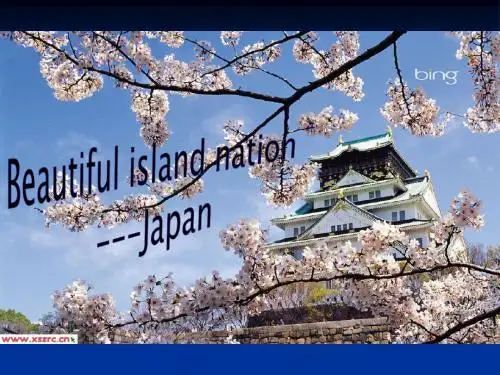
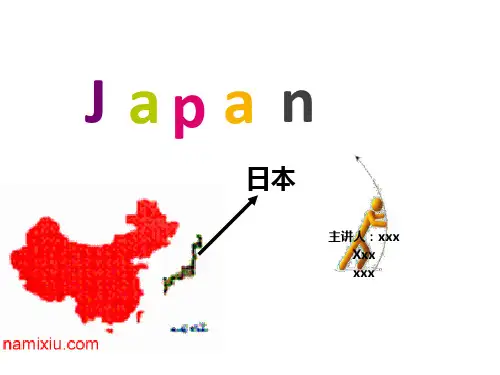

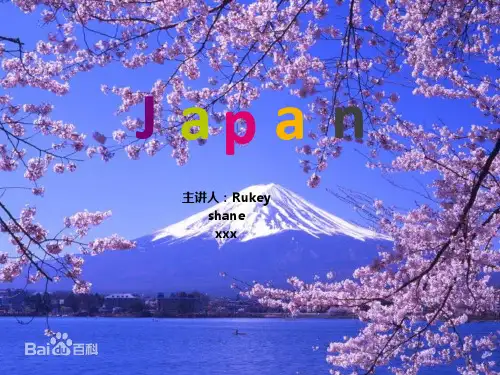
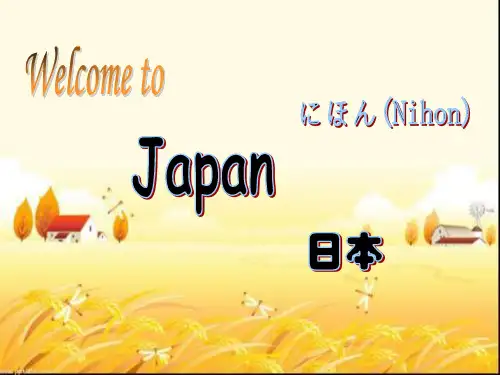
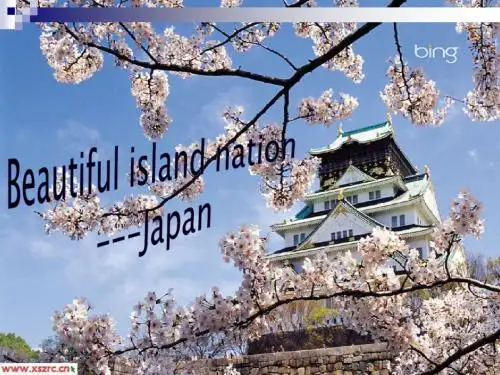
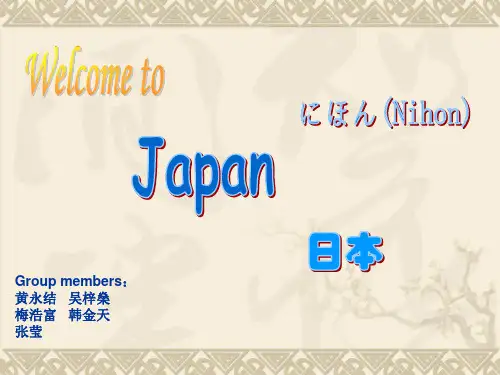
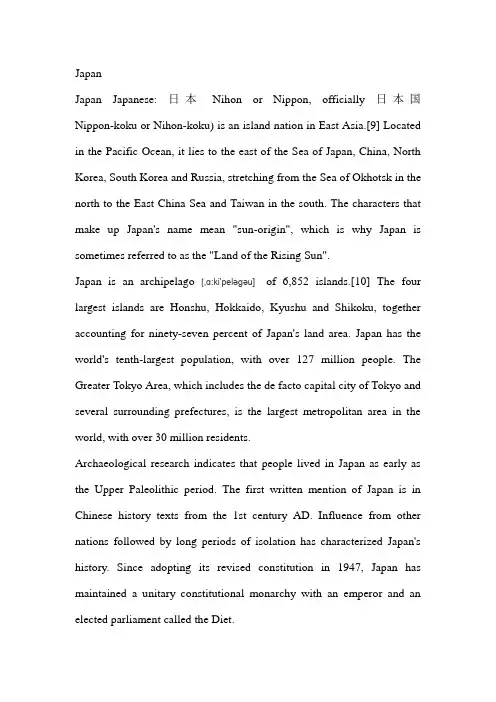
JapanJapan Japanese: 日本Nihon or Nippon, officially 日本国Nippon-koku or Nihon-koku) is an island nation in East Asia.[9] Located in the Pacific Ocean, it lies to the east of the Sea of Japan, China, North Korea, South Korea and Russia, stretching from the Sea of Okhotsk in the north to the East China Sea and Taiwan in the south. The characters that make up Japan's name mean "sun-origin", which is why Japan is sometimes referred to as the "Land of the Rising Sun".Japan is an archipelago [,ɑ:ki'peləɡəu]of 6,852 islands.[10] The four largest islands are Honshu, Hokkaido, Kyushu and Shikoku, together accounting for ninety-seven percent of Japan's land area. Japan has the world's tenth-largest population, with over 127 million people. The Greater Tokyo Area, which includes the de facto capital city of Tokyo and several surrounding prefectures, is the largest metropolitan area in the world, with over 30 million residents.Archaeological research indicates that people lived in Japan as early as the Upper Paleolithic period. The first written mention of Japan is in Chinese history texts from the 1st century AD. Influence from other nations followed by long periods of isolation has characterized Japan's history. Since adopting its revised constitution in 1947, Japan has maintained a unitary constitutional monarchy with an emperor and an elected parliament called the Diet.A major economic power,[2] Japan has the world's third-largest economy by nominal GDP[11] and by purchasing power parity购买力平价. It is also the world's fourth largest exporter and fourth largest importer. Although Japan has officially renounced its right to declare war, it maintains an extensive modern military force in self-defense and peacekeeping roles. After Singapore, Japan has the lowest homicide (including attempted homicide) rate in the world.[12] According to both UN and WHO estimates, Japan has the longest life expectancy of any country in the world. According to the UN, it has the third lowest infant mortality rate。
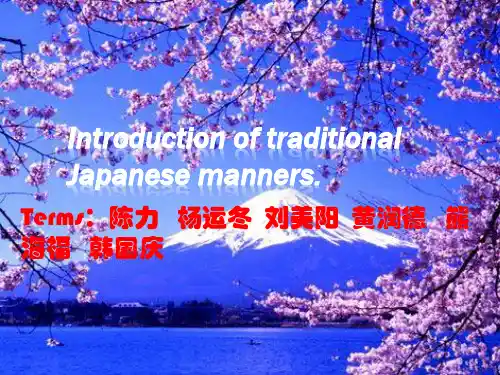
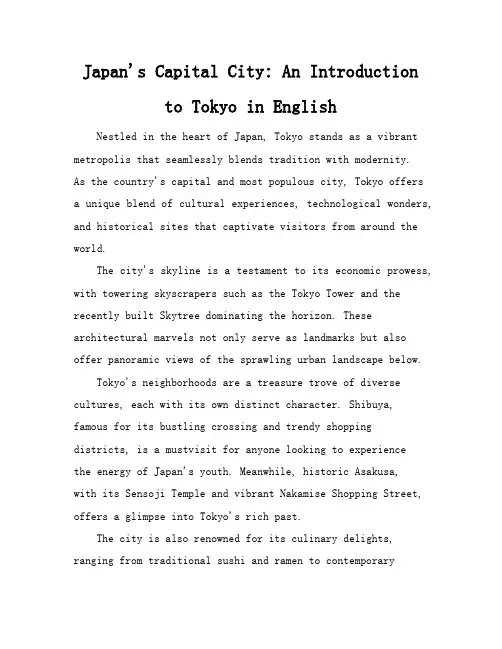
Japan's Capital City: An Introductionto Tokyo in EnglishNestled in the heart of Japan, Tokyo stands as a vibrant metropolis that seamlessly blends tradition with modernity.As the country's capital and most populous city, Tokyo offers a unique blend of cultural experiences, technological wonders, and historical sites that captivate visitors from around the world.The city's skyline is a testament to its economic prowess, with towering skyscrapers such as the Tokyo Tower and the recently built Skytree dominating the horizon. These architectural marvels not only serve as landmarks but alsooffer panoramic views of the sprawling urban landscape below.Tokyo's neighborhoods are a treasure trove of diverse cultures, each with its own distinct character. Shibuya, famous for its bustling crossing and trendy shoppingdistricts, is a mustvisit for anyone looking to experiencethe energy of Japan's youth. Meanwhile, historic Asakusa,with its Sensoji Temple and vibrant Nakamise Shopping Street, offers a glimpse into Tokyo's rich past.The city is also renowned for its culinary delights, ranging from traditional sushi and ramen to contemporaryfusion cuisine. Tokyo's food scene is a delightful mix of street food stalls, cozy izakayas, and worldclass restaurants, ensuring that there's something to satisfy every palate.In terms of transportation, Tokyo boasts one of the most efficient and extensive public transit systems in the world. The subway and train networks are clean, punctual, and easily navigable, making it a breeze for both locals and tourists to explore the city.From the serene gardens of Ueno Park to the excitement of Akihabara's electronic district, Tokyo offers a diverse array of attractions that cater to a wide range of interests. Whether you're a history buff, a fashion enthusiast, or atech aficionado, Tokyo has something extraordinary in storefor you.Japan's Capital City: An Introduction to Tokyo in English (Continued)Beyond the bright lights and bustling streets, Tokyo is a city that thrives on its contradictions. It's a place where ancient shrines can be found nestled among cuttingedge technology, and where the fastpaced rhythm of city life is often interrupted moments of tranquility.One such oasis of calm is the Meiji Shrine, hidden awayin a lush forest within the heart of Shibuya. This Shinto shrine, dedicated to Emperor Meiji and his consort, is aserene escape from the city's hustle, offering a peaceful walk through a beautiful torii gate and into a world where nature and spirituality coexist.Shopping in Tokyo is an experience like no other. The upscale districts of Ginza and Omotesando offer a chance to peruse luxury brands in elegant settings, while the backstreets of Harajuku are where you'll find quirky boutiques and independent shops that cater to the city's fashionforward youth.Tokyo's nightlife is equally diverse, with options ranging from traditional izakayas where you can enjoy a casual drink and small plates, to highend cocktail bars that offer sophisticated libations with a view. The city's karaoke culture is also not to be missed, providing an entertaining way to spend an evening with friends.For those seeking a more contemplative experience, avisit to the Tsukiji Outer Market allows you to witness the early morning tuna auctions and indulge in some of the freshest sushi and seafood available. It's a sensory overload that's well worth the early wakeup call.Education is highly valued in Tokyo, with the city being home to some of the world's top universities. Tokyo University, in particular, is renowned for its academicexcellence and beautiful campus, which is a testament to the city's blend of modernity and tradition.In Tokyo, every season brings its own charm. Cherry blossom season in spring is a time for hanami parties under blooming sakura trees, while autumn paints the city invibrant hues of red and gold. Winter brings a quiet beauty, with the possibility of snow dusting the city's landmarks, and summer is a season of festivals and outdoor activities.Tokyo is a city that never stops evolving, yet it remains deeply rooted in its heritage. It's a place where every corner turned, every meal enjoyed, and every conversation had is a new chapter in the everunfolding story of this remarkable city. Whether you're visiting for a short time or planning to stay longer, Tokyo will undoubtedly leave an indelible mark on your heart.Japan's Capital City: An Introduction to Tokyo in English (Continued)The city's entertainment districts, such as Kabukicho in Shinjuku and Roppongi, are buzzing with activity. Here, you can find everything from themed cafes where you can dine with robots or cats, to cozy jazz bars that transport you back in time with smooth melodies and classic cocktails.For a more cultural night out, consider attending a traditional Japanese theater performance. Kabuki, Noh, andBunraku puppet theater are all part of Tokyo's rich cultural tapestry and can be experienced in theaters across the city. These performances are not just shows but a window into the soul of Japanese art and storytelling.Sports enthusiasts will find plenty to love in Tokyo as well. The city is home to several professional sports teams, and attending a baseball game at the iconic Tokyo Dome or a sumo tournament at Ryogoku Kokugikan is an unforgettable experience. The energy and passion of the fans are infectious, and these events offer a glimpse into the importance ofsports in Japanese culture.In conclusion, Tokyo is a city of endless discovery. It's a place where the old and the new live side side in harmonious coexistence. Whether you're walking through the historic streets of Edo or marveling at the futuristic skyline, Tokyo will always have something new to offer. It'sa city that thrives on its diversity, innovation, and rich cultural heritage, making it one of the most captivating destinations in the world.。
JapanJapanAdd To WorkspaceBritannica Elementary ArticleOnline SearchWorld DataView Table of ContentsNotes ViewerMinimize ToolbarMaximize ToolbarFindPrintSaveBookmarkPreferencesTake a NoteShow NotesHide NotesIntroductionFlag of JapanJapan is a country marked by contrast between old and new. The country values its complex and ancient cultural tradition. Yet life in modern Japan is increasingly focused on cities and modern technology. In the second half of the 1900s, Japan emerged as one of the world's most economically and technologically advanced societies.Japan is located off the east coast of Asia. The country consists of a string offour large islands and more than 3,900 smaller islands. From north to south, the main islands are Hokkaido, Honshu, Shikoku and Kyushu. The largest is Honshu, which is regarded as the Japanese mainland. The Ryukyu Islands, including Okinawa, arc to the south and west of Kyushu. Tokyo, on Honshu, is the capital and one of the world's largest cities.GeographyThe islands of Japan form an arc that stretches about 2,400 kilometres (1,500 miles) from north-east to south-west. Japan has no land border with any other country. The open waters of the Pacific Ocean border Japan's eastern andsouth-eastern shores. China is to the south-west, across the East China Sea.North and South Korea are to the west, across the Sea of Japan. Russia lies across the Sea of Japan to the north-west and the Sea of Okhotsk to the north. Japan has a total land area of 377,835 kilometres (145,883 square miles). Mountains cover more than 80 per cent of Japan's land surface. They divide the islands into hundreds of smaller sections. The largest and highest mountain mass lies in central Honshu. Part of the range is known as the Japanese Alps. Manyshort river valleys and small lowland plains interrupt the mountain ranges. Mostof the plains lie along the coast.Japan experiences hundreds of earthquakes every year. Most of them are minor, but a few are devastating. Undersea earthquakes sometimes stir up tsunamis, or huge sea waves. The country also has many volcanoes, both active and inactive. Mount Fuji, in central Honshu, has been inactive since 1707. With a height of3,776 metres (12,388 feet), it is Japan's highest mountain.Plants and AnimalsMuch of Japan's original vegetation has been replaced by farming or by plant species brought in from other countries. Forests cover a large part of the land. Pine, cypress, hemlock, cedar, fir and spruce are commercially valuable evergreens. The numerous broad-leaved trees include oak, maple, ash, birch, beech and poplar. Bamboo and palms grow in southern and central Japan.The cherry tree is planted throughout the country and occurs naturally in partsof the mountains. It is celebrated for its beautiful spring blossoms. The cherrytree has long been one of the symbols of Japan.Many animals live in the country's remote, forested mountain regions. The mammals include bears, foxes, deer, wild boars, antelope, hares and wild monkeys. The seas are home to whales, dolphins, porpoises and a wide variety of commercially valuable fish. The raising of goldfish and colourful carp for decorative purposes is a Japanese speciality.PeopleThe great majority of the Japanese people share the same ethnic and cultural background. They are closely related to the other peoples of eastern Asia. There are, however, several minority groups. Koreans form the largest minority group. Many of them were born in Japan. The burakumin (‘people of the village') are ethnically the same as the majority of Japanese. However, their ancestors were members of the former outcast class. The burakumin are often treated unfairly.In addition, there are small numbers of Ainu, a native people of northern Japan. The relatively tiny foreign community in Japan is composed largely of Chinese.Buddhists visit the Kiyomizu temple, in Kyoto, Japan.The country's official language is Japanese. Shinto and Buddhism are the main religions. Shinto is based on the worship of local spirits in nature. Itoriginated in Japan. A small proportion of the population is Christian. On Honshu are most of Japan's largest cities, including Tokyo, Yokohama, Osaka, Kobe, Nagoya, Kyoto, Kawasaki and Hiroshima. About 80 per cent of the country's people live on Honshu.CultureJapan has a rich and complex culture. Native Japanese traditions have been mixed with cultural styles adapted from China and, later, from the West. Japaneseculture and art emphasise understated simplicity, elegance and grace. For example, the traditional Japanese tea ceremony, flower arranging and gardendesign are highly stylised and refined. On the other hand, contemporary Japanese society fully embraces Western-style popular culture – influenced by television,films and advertising.LiteratureJapan has a long and vibrant literary tradition. The Tale of Genji is consideredthe world's first important novel. It was written in the early 1000s by Shikibu Murasaki, a lady of the Kyoto court. Renowned modern Japanese writers include Soseki Natsume, Ryunosuke Akutagawa, Osamu Dazai, Jun'ichiro Tanizaki and Yukio Mishima. Japanese novelist Yasunari Kawabata won the Nobel Prize for Literaturein 1968.Poetry plays a central role in Japanese culture. Occasions of many kinds are celebrated with poems. The most common forms are haiku and tanka – short, unrhymed poems with a certain number of syllables in each line.Visual ArtsIn classical Japanese painting, black ink and watercolours were used ontissue-thin silk. The carefully composed paintings used few brush strokes tosuggest a scene in nature. Ukiyo-e, or ‘pictures of the floating world',depicted the life of common people. Japanese woodcuts of the 1600s and 1700swere among the finest examples of ukiyo-e.Performing ArtsTraditional Japanese theatre combines music, dance and drama. In puppet plays called Bunraku, nearly life-sized dolls are used to act out a chanted story.Japanese No plays are generally short, stylised and heroic. The actors andchorus chant fine poetry. While No theatre was originally restricted to theupper classes, Kabuki was the theatre of the townspeople and farmers. Kabukiplays are colourful spectacles of singing, dancing, mime and melodrama.Martial ArtsThe martial arts in Japan originated with medieval warriors, the samurai, whoused them in battle. Today the martial arts are more important as competitivesports and as aids to physical and mental fitness. The most popular forms aresumo wrestling, judo, aikido, karate and kendo.EconomyJapan was defeated in World War II (1939–45), with great loss of life and property. Yet after the war it emerged as one of the most advanced economicpowers in the world. The Japanese economy grew remarkably throughout the 1960s, 1970s and 1980s. Manufacturing developed especially rapidly. However, the economy slowed greatly in the early 1990s and suffered a major downturn at theend of the decade. Nevertheless, Japan remained an economic superpower.Japan's economy has revolved primarily around manufacturing and trade. TheJapanese are the leading makers of ships, cars and advanced electronics and equipment – especially television sets, DVD players, computers, cameras, microwave ovens, watches, photocopiers and robots. The country has some of the world's largest and most advanced industrial plants. It is a major producer ofcrude steel, synthetic rubber, aluminium, chemicals, plastics, cement and pulpand paper.Farming and fishing contribute only about two per cent of the national income.Rice is the most important food and the main crop. Other leading crops include wheat, barley, potatoes, sugar beets, fruit, vegetables and tea. A small numberof cattle and hogs are raised. Japan relies heavily on the sea as a source offood. It has one of the largest fish catches of any nation in the world.HistoryAncient JapanPeople were living in Japan at least 10,000 years ago. According to legend, the Japanese state was founded in 660 BC by the emperor Jimmu. Historical records, however, show that Japan was not united as one state until the late AD 300s or400s. It was ruled by the Yamato dynasty.During the Yamato period, Buddhism arrived in Japan from Korea. In addition, for many centuries the Japanese borrowed heavily from Chinese culture. The Japanese adopted Chinese characters to write the Japanese language. Imperial courts basedon Chinese models appeared in Japan in the 700s.From the 800s to the 1100s the Fujiwara family dominated Japan. This period wasa classic age of art and literature. Japan's culture no longer borrowed fromChina but became distinctively Japanese.Military GovernmentDuring the 1100s a class of warriors called samurai rose to power. However, the emperor continued to hold some authority. The samurai had sophisticated military skills. They developed a disciplined way of living, which followed a code ofconduct based on loyalty and sacrifice.In the late 1100s Yoritomo Minamoto established Japan's first militarygovernment at Kamakura. Minamoto was named shogun, or chief military commander, and his government was called a shogunate. Except for periods of internalwarfare, this form of government persisted until 1868.Meanwhile, Japan was developing trade contacts with the outside world. Official trade missions to China began in 1404. In 1543, Portuguese traders arrived,followed by the Spanish, English and Dutch. Some of the Japanese converted to Christianity.UnificationThe government's division and disorder ended in the late 1500s. By 1590 Toyotomi Hideyoshi had brought the region under his control. After Hideyoshi's death in 1598, his supporter Ieyasu Tokugawa took over. Under Tokugawa, the country was again united under a strong shogunate.For the next two centuries, Japan enjoyed great peace and stability. A nationalmarket developed, and the economy flourished. Advances were made in farming techniques. Osaka and Edo (now named Tokyo) became great commercial and cultural centres.The period was also marked by isolation. The Tokugawa government feared that Japan was being prepared for foreign conquest. The Tokugawa banned Christianity and expelled almost all foreigners. Japan cut back on foreign trade. Inaddition, the Japanese were forbidden to leave the country.By the mid-1800s the Tokugawa shogunate was unable to keep European and United States traders away. The Tokugawa's support among the Japanese people collapsed.In 1868 the Tokugawa shogun was forced to step down.The Meiji EmperorA new government was established under the young emperor Mutsuhito, who took the name of Meiji, meaning ‘enlightened government'. This transfer of power from the Tokugawa shogunate to the Meiji emperor is known as the Meiji Restoration. It is regarded as the beginning of Japan's modern era.ExpansionJapan soon sought to build an empire. It successfully fought a war with China (1894–95) and with Russia (1904–05). As a result, Japan took over some of thetwo countries' possessions in East Asia. It made Korea into a Japanese colony in 1910.During World War I (1914–18), Japan fought on the side of the Allied powers (mainly Britain, France and Russia). The Allied powers won the war. Japan's involvement was limited, but it seized additional territory in East Asia from Germany.World War IIBy 1930 Japan faced a financial crisis. The Japanese government believed that expansion through military conquest would help the economy. In 1931 Japan seized Manchuria from China. Japan moved troops into China in 1937 and into French Indochina in 1940. The Japanese signed the Tripartite Pact, forming an alliancewith Germany and Italy. The three countries formed the Axis powers. They fought against the Allied powers, mainly Britain, France, Russia and China during World War II.The United States tried to stop Japan's aggression in East Asia by banning shipments of oil to Japan. In December 1941 Japan attacked the United Statesforces at Pearl Harbor, Hawaii, which pulled the United States into war. After experiencing early successes on every front, the Japanese forces were gradually pushed back by the United States and other Allied troops. In August 1945 theUnited States dropped atom bombs on the Japanese cities of Hiroshima and Nagasaki. The cities were largely destroyed. Shortly thereafter the Japanese surrendered. (See also World War II.)Post-war JapanUnder the terms of surrender, Japan had to give up all the territory it hadacquired since 1895. In addition, United States forces occupied Japan until 1952. Japan's military was disbanded. Political, social and educational reforms encouraged the growth of democracy. A new constitution in 1947 gave great power to the elected legislature and took power away from the emperor.Japan rebuilt its ruined economy, using new technology in every major industry. Its spectacular growth was called an ‘economic miracle'. By the 1990s Japan had one of the world's largest economies. After 1990 growth slowed considerably, but the economy showed a small upturn again in the early 2000s. Population (2007 estimate), 127,433,000.Back to TopTo cite this page:MLA Style: "Japan." Britannica Elementary Library. Encyclopdia BritannicaStudent and Home Edition. Chicago: Encyclopdia Britannica, 2011.APA Style: Japan. (2011). Britannica Elementary Library. EncyclopdiaBritannica Student and Home Edition. Chicago: Encyclopdia Britannica.Table of Contents : Notes ViewerLoading...CloseDelete Selected Notes。
日本英文简介作文Title: Discovering the Charm of Japan: An English Introduction。
Japan, a land of captivating contrasts, where tradition and modernity coexist harmoniously, beckons travelers from across the globe to immerse themselves in its rich culture, stunning landscapes, and culinary delights. From the bustling streets of Tokyo to the serene temples of Kyoto, Japan offers a plethora of experiences that leave an indelible mark on visitors. In this introduction, we embark on a journey to unravel the essence of Japan and explore the myriad wonders it has to offer.At the heart of Japan's allure lies its deep-rooted culture, which seamlessly blends ancient traditions with contemporary influences. One cannot help but be mesmerized by the elegant art of the tea ceremony, the graceful movements of traditional Japanese dance, or the intricate craftsmanship of pottery and calligraphy. Each aspect ofJapanese culture reflects a profound respect for tradition and a relentless pursuit of excellence.Yet, Japan is also a country of innovation and progress, where cutting-edge technology coexists with centuries-old customs. The bustling metropolis of Tokyo stands as a testament to Japan's forward-thinking spirit, with its towering skyscrapers, futuristic gadgets, and vibrantstreet life. Here, one can witness the relentless pace of modernity while still finding pockets of tranquility inlush parks and serene shrines.Beyond the urban sprawl, Japan's natural beauty awaits, captivating visitors with its diverse landscapes and breathtaking vistas. From the snow-capped peaks of MountFuji to the idyllic countryside dotted with rice paddiesand cherry blossoms, Japan's scenery is nothing short of enchanting. Nature plays a central role in Japanese culture, inspiring artistic expressions such as haiku poetry and traditional landscape painting.Of course, no exploration of Japan would be completewithout indulging in its world-renowned cuisine. Japanese food is a celebration of flavors, textures, and aesthetics, where every dish is crafted with meticulous attention to detail. Whether savoring sushi at a high-end restaurant or slurping noodles at a humble ramen shop, every meal in Japan is an unforgettable experience.But perhaps the most enduring impression of Japan is the warmth and hospitality of its people. From the moment you set foot in this island nation, you are greeted with genuine kindness and courtesy. Whether seeking directions from a stranger or engaging in conversation with a local, you are met with a genuine eagerness to help and a deep sense of respect.In conclusion, Japan is a land of endless discovery, where ancient traditions meet modern innovation, and natural beauty abounds at every turn. Whether you're drawn to its rich cultural heritage, its dynamic cities, or its stunning landscapes, Japan offers something for every traveler. So come, immerse yourself in the charm of Japan and create memories that will last a lifetime.。
日本英语自我介绍Here is an English essay of more than 1,000 words on the topic "Japanese Self-Introduction in English":Hello everyone my name is Takeshi Tanaka I am from Tokyo Japan I am 28 years old I work as an engineer at a technology company in the heart of Tokyo I have lived in Japan my whole life and I am very proud of my Japanese heritage and culture however I also have a great interest in the English language and Western culture which is why I am here today to introduce myself to you in EnglishTo begin I was born and raised in the bustling city of Tokyo which is the capital of Japan and one of the largest metropolitan areas in the world Tokyo is an incredibly vibrant and modern city with towering skyscrapers futuristic architecture renowned cuisine and a rich cultural heritage It is a city that seamlessly blends the old and the new where you can find ancient shrines and temples alongside the latest high-tech innovations and fashion trends I have always loved living in Tokyo as there is always something new to discover and experience whether it is trying the latest trendy restaurant visiting a historic landmark or attending a traditional festivalGrowing up in Tokyo I was fortunate to receive an excellent education I attended a highly competitive private school from elementary through high school where I excelled academically particularly in the fields of math and science This strong foundation in STEM subjects led me to pursue an engineering degree at the prestigious University of Tokyo after graduating from high school At university I specialized in electrical engineering and developed a deep passion for technology and innovation During my studies I was involved in several research projects and internships where I was able to apply my technical knowledge to real-world problems and challenges This hands-on experience combined with my academic achievements allowed me to secure a position at a leading technology company in Tokyo after graduationIn my current role as an electrical engineer I am responsible for designing and developing new hardware and software solutions for our products I work closely with cross-functional teams including product managers designers and developers to bring innovative technologies to market I particularly enjoy the problem-solving aspects of my job as I am constantly faced with complex technical challenges that require creative thinking and innovative solutions I take great pride in being able to contribute to the development of cutting-edge technologies that have a positive impact on people's livesOutside of work I have a number of hobbies and interests that keep me busy First and foremost I am an avid reader I love exploring new ideas and perspectives through literature whether it is classic novels non-fiction works or the latest bestsellers I also enjoy staying physically active and healthy I am an enthusiastic cyclist and I try to ride my bike to work whenever the weather permits I also enjoy hiking and rock climbing in the beautiful natural landscapes that surround Tokyo on the weekends Additionally I have a deep appreciation for traditional Japanese arts and culture I regularly attend Noh theater performances and tea ceremonies to immerse myself in these time-honored traditions I find the elegance and precision of these art forms to be truly captivatingOne of my biggest passions however is learning and practicing the English language I have been studying English since I was a young child and I have worked hard to become fluent Over the years I have traveled to several English-speaking countries including the United States the United Kingdom and Australia which has allowed me to improve my conversational skills and gain a deeper understanding of Western culture and customs I particularly enjoy engaging in intellectual discussions and debates in English as I find the language to be remarkably expressive and nuanced I am constantly in awe of the sheer breadth and complexity of the English vocabulary and grammarIn fact my love of the English language is a big part of why I am here today to introduce myself to all of you I believe that being able to communicate effectively in English is an invaluable skill in our increasingly globalized world and I am eager to continue improving my English proficiency through conversations and interactions with native speakers I hope that by sharing a bit about myself and my background I can demonstrate my passion for bridging cultural divides and fostering greater cross-cultural understanding and collaborationIn conclusion I am a curious and driven individual who is deeply proud of my Japanese heritage while also maintaining a strong interest in Western culture and the English language I am grateful for the many opportunities I have had to learn grow and explore the world and I look forward to continuing on this journey of personal and professional development Thank you all for listening I am happy to answer any questions you may have。